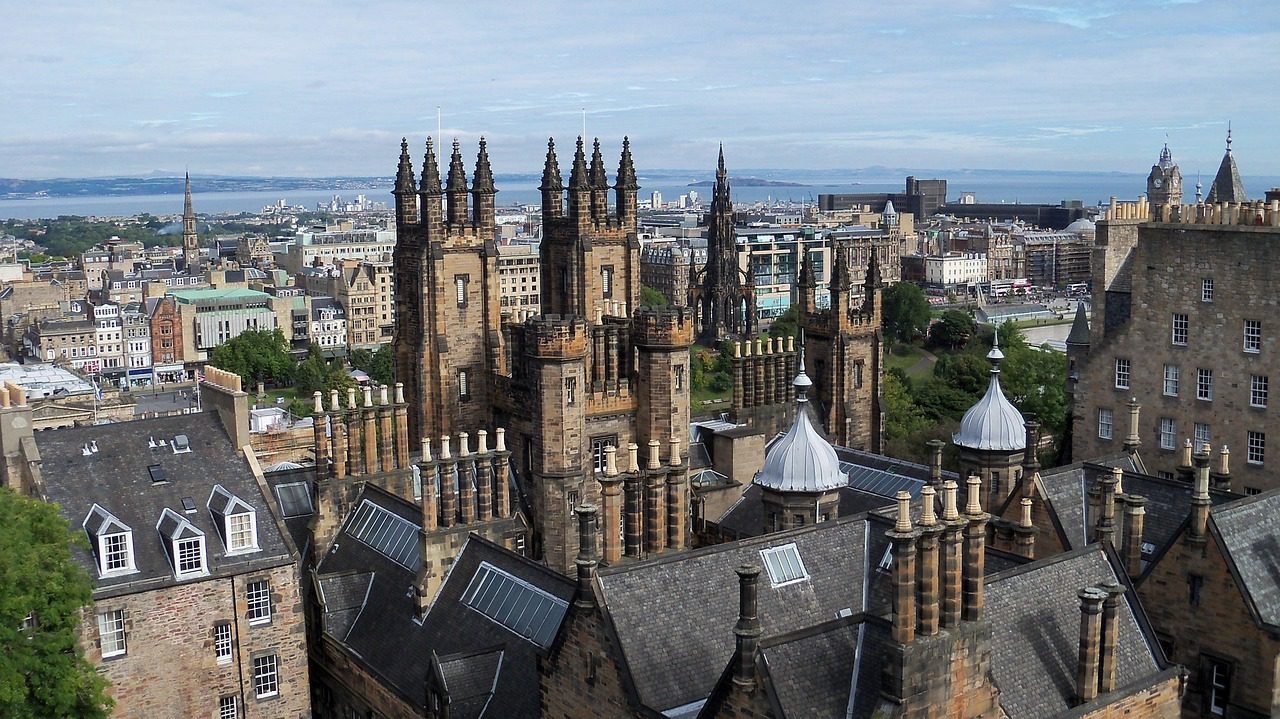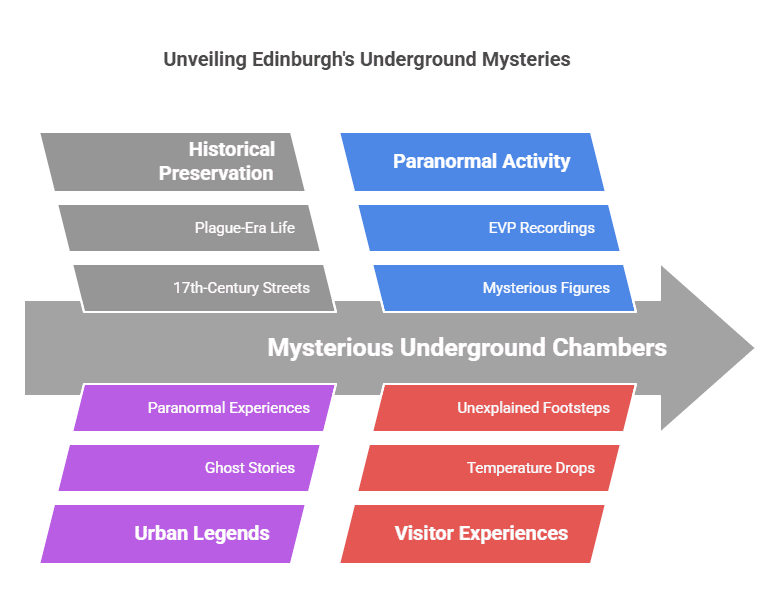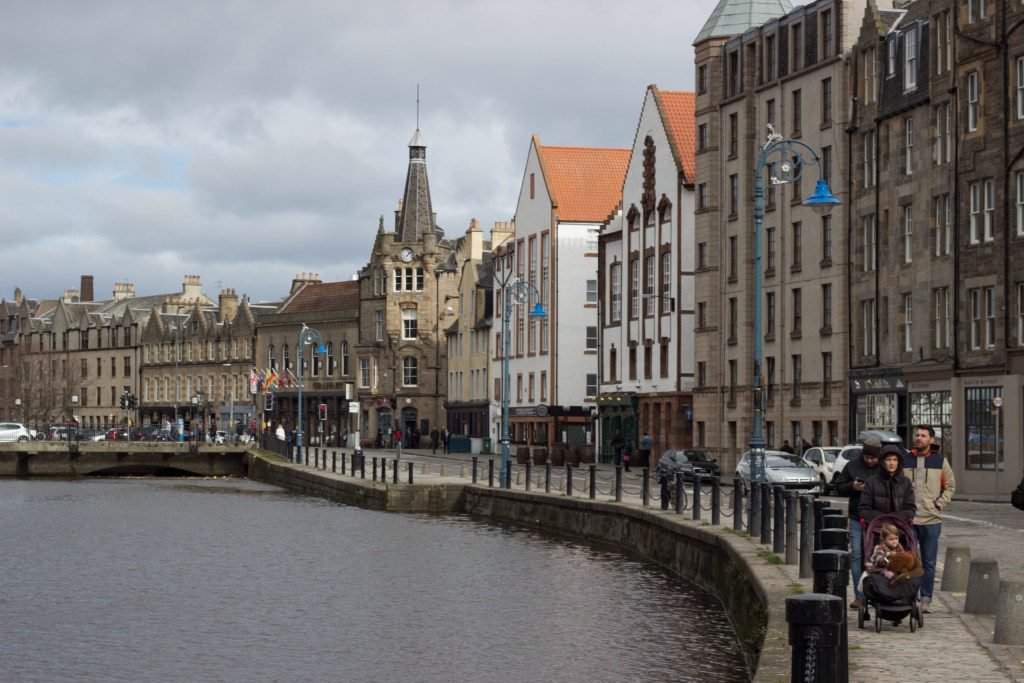Must-Visit Edinburgh Landmarks

Edinburgh’s enchanting allure is impossible to resist—a city where every cobblestone whispers tales of centuries past. As you wander among must-visit Edinburgh landmarks like the ancient Royal Mile, you’ll drift between worlds: the medieval Old Town, crowned by its iconic castle and haunted underground vaults, and the Georgian New Town’s elegant crescents, where neoclassical grandeur meets modern vibrancy.
Here, Scotland’s capital invites you to unravel a story where history and innovation collide, and every moment weaves together traditional Scottish heritage and vibrant contemporary charm.
Key Takeaways:
- Edinburgh seamlessly blends its medieval Old Town and Georgian New Town, both UNESCO World Heritage sites, offering visitors a unique journey through different historical periods.
- The city’s rich supernatural folklore and underground vaults have earned it recognition as one of Europe’s most haunted destinations, with countless ghost tours and mystical tales.
- Edinburgh Castle, perched on an extinct volcano, remains the city’s most iconic landmark and houses Scotland’s Crown Jewels and the Stone of Destiny.
- The Royal Mile, stretching from Edinburgh Castle to Holyrood Palace, serves as the historic heart of the city, featuring centuries-old buildings, hidden closes, and traditional Scottish shops.
- Literary heritage runs deep in Edinburgh, being the world’s first UNESCO City of Literature and home to famous authors like Sir Walter Scott and Robert Louis Stevenson.
Historical Evolution of Edinburgh
To understand Edinburgh’s soul, you must journey through its remarkable transformation from a hillfort to Scotland’s capital.

Your exploration will reveal a city that has evolved through Celtic settlements, Roman influences, and medieval grandeur.
Each era has left an indelible mark on Edinburgh’s landscape, creating the captivating fusion of ancient and modern that you see today.
Medieval Origins and Castle Rock
At the heart of Edinburgh’s story stands the imposing Castle Rock, where your journey begins.

This volcanic plug, inhabited since the Iron Age, became the foundation of Edinburgh Castle.
You’ll find yourself walking the same paths where ancient Celtic tribes established their stronghold, later fortified by medieval Scottish monarchs into what became the most besieged place in Britain.
The Tale of Two Cities: Old and New Towns
Beside each other, you’ll discover two distinct worlds that showcase Edinburgh’s unique character.

The medieval Old Town, with its towering tenements and narrow closes, contrasts dramatically with the elegant Georgian New Town.
Your exploration reveals how this UNESCO World Heritage site represents one of the most remarkable urban planning achievements in history.
Medieval overcrowding in the Old Town led to what you’ll recognize as a revolutionary solution.
The pristine New Town development began in 1767, featuring your perfect example of Georgian architecture with its ordered squares and crescents.
The contrast between the chaotic medieval streets and the rational grid pattern of the New Town tells the story of a city divided by time but united in grandeur.
Architectural Heritage
If you’re seeking architectural wonders, Edinburgh stands as a living museum of design through the ages.
The city’s UNESCO World Heritage status embraces both the medieval Old Town and the Georgian New Town, offering you a unique glimpse into centuries of architectural evolution.
For a comprehensive exploration of these magnificent structures, check out A First-Timer’s Guide to Edinburgh: Must-See Attractions and Local Favorites.
Gothic and Neoclassical Masterpieces
Gothic splendor meets neoclassical grandeur in Edinburgh’s skyline. You’ll find yourself surrounded by towering spires and flying buttresses of St Giles’ Cathedral, while the majestic columns of the National Gallery showcase the city’s neoclassical heritage.

These architectural styles blend seamlessly, creating a unique urban landscape that transports you through centuries of design evolution.
The Royal Mile’s Historic Buildings
One of Edinburgh’s most captivating thoroughfares, the Royal Mile, presents you with an extraordinary collection of historic buildings.
Your walk along this ancient street reveals centuries-old tenements, charming closes, and magnificent landmarks like John Knox House and the Canongate Tolbooth, each telling its own story of Scotland’s capital.

Indeed, your exploration of the Royal Mile’s architecture unveils layers of history in every stone.
From the secret underground vaults to the towering merchant houses, each building showcases unique architectural features from different periods.
You’ll discover ornate doorways, decorative cornices, and hidden courtyards that make this mile-long stretch a living testament to Edinburgh’s architectural evolution.
Cultural Landmarks
Keep your eyes peeled for Edinburgh’s most iconic landmarks that tell tales spanning nearly a millennium.
As you explore the city, you’ll discover how these architectural marvels have shaped Scotland’s identity, from medieval fortifications to sacred sanctuaries.
These UNESCO World Heritage sites offer you a glimpse into the city’s royal heritage and religious evolution.
Edinburgh Castle and Palace of Holyroodhouse
Below the dramatic skyline, you’ll find Edinburgh’s most commanding presence – the Castle, perched atop an extinct volcano.
Your journey along the Royal Mile leads you from this mighty fortress to the elegant Palace of Holyroodhouse, the Queen’s official Scottish residence.
These royal landmarks bookend your exploration of the historic heart of Edinburgh.
St. Giles’ Cathedral and Greyfriars Kirk
Around the corner from the Royal Mile, you’ll encounter two of Edinburgh’s most significant religious sites.
The crown spire of St. Giles’ Cathedral pierces the sky, while Greyfriars Kirk stands as a testament to Scotland’s turbulent religious history.
Your visit to these sacred spaces connects you with centuries of Scottish spiritual heritage.

Considering your interest in local legends, you’ll find these sites particularly fascinating. St. Giles’ houses the beautiful Thistle Chapel, while Greyfriars Kirk is home to the touching tale of Greyfriars Bobby, the loyal dog who guarded his master’s grave for 14 years.
The kirkyard also holds darker secrets, including the infamous Mackenzie Poltergeist, known for causing unexplained scratches and burns on visitors.
Literary Legacy
Now you can explore Edinburgh’s rich literary heritage, which has earned it the title of UNESCO’s first City of Literature. As you walk these historic streets, you’ll find yourself following in the footsteps of literary giants like Robert Louis Stevenson, Sir Walter Scott, and J.K. Rowling.
The city’s winding alleys, gothic architecture, and mysterious atmosphere have inspired countless stories that continue to captivate readers worldwide.
Famous edinburgh authors’ landmarks
On your visit to the Writers’ Museum in Lady Stair’s Close, you’ll discover fascinating artifacts and personal belongings of Scotland’s most celebrated authors.

Your journey through this 17th-century building reveals intimate glimpses into the lives of Robert Burns, Sir Walter Scott, and Robert Louis Stevenson, offering a deeper understanding of how Edinburgh shaped their masterpieces.
The Edinburgh International Book Festival
For three weeks each August, you can immerse yourself in the world’s largest celebration of literature.

The Edinburgh International Book Festival transforms Charlotte Square Gardens into a literary haven, where you’ll encounter renowned authors, participate in engaging discussions, and experience the vibrant contemporary literary scene.
Literary enthusiasts will find themselves surrounded by over 800 authors from 40 countries during the festival.
Your experience can include attending book signings, workshops, and panel discussions, while children’s programs and storytelling sessions make it a family-friendly event.
The festival’s inclusive atmosphere welcomes both established and emerging voices, creating an unparalleled celebration of the written word.
Mysterious Underground
Once again, Edinburgh reveals its darker side beneath your feet. The city’s underground chambers and passages form a hidden world where you’ll discover centuries of history preserved in stone.
These subterranean spaces, originally ordinary streets and homes, were buried as the city grew upward, creating a mysterious network that tells tales of plague, poverty, and perseverance in medieval Edinburgh.
Mary King’s Close and Vaults
Mysterious passages of Mary King’s Close and the South Bridge Vaults invite you into Edinburgh’s underground realm.
These perfectly preserved 17th-century streets offer an authentic glimpse into daily life during the plague years.

You’ll walk through actual homes where residents once lived and worked, experiencing the eerie atmosphere of spaces that witnessed both ordinary life and extraordinary hardship.
Ghost Stories and Urban Legends
Urban myths and spectral tales permeate Edinburgh’s underground spaces. From the spirit of little Annie in Mary King’s Close to the malevolent presence in the vaults, you’ll encounter stories that have frightened and fascinated visitors for generations.
These dark chambers have become Scotland’s most actively haunted locations, drawing paranormal investigators from around the world.
But there’s more to these haunting tales than mere folklore. Historical records document countless incidents of unexplained phenomena in these spaces.
You might feel sudden temperature drops, hear unexplained footsteps, or even encounter mysterious figures during your visit.
Professional ghost hunters have captured EVP recordings and photographs that defy explanation, making these underground chambers a must-visit destination for those seeking authentic paranormal experiences.
Modern Edinburgh
Many aspects of Edinburgh’s contemporary landscape blend seamlessly with its historic character.
You’ll find cutting-edge architecture like the Scottish Parliament building standing proudly alongside centuries-old structures.

The city continues to evolve while preserving its cultural heritage, offering you a unique mix of old-world charm and modern amenities in areas like the revitalized Leith waterfront and the dynamic financial district.
Festival City and Arts Scene
Along with hosting the world’s largest arts festival, the Edinburgh Fringe, your cultural calendar can be filled year-round with diverse artistic experiences.
You’ll discover contemporary galleries in repurposed spaces, innovative theater productions, and vibrant music venues.
The city’s festival scene has transformed Edinburgh into a global cultural hub, attracting millions of visitors and artists annually.
Contemporary Culture and Innovation
Against the backdrop of historic spires, you’ll find Edinburgh’s thriving tech startup ecosystem and world-class research institutions.
Your exploration will reveal a city at the forefront of artificial intelligence, biotech, and financial technology, while maintaining its reputation as a UNESCO City of Literature.
Hence, your journey through modern Edinburgh reveals a city that successfully balances innovation with tradition.
You can experience this fusion in the creative hubs of Fountainbridge and the Quartermile, where former industrial spaces now house cutting-edge businesses and artistic ventures.
The city’s commitment to sustainability and smart city initiatives ensures that your future visits will find Edinburgh continuing to evolve while preserving its unique character.
Final Words
With this in mind, your journey through Edinburgh reveals a city that masterfully weaves its ancient charm with modern vibrancy.
As you explore the winding cobblestone streets, climb the historic castle, and immerse yourself in the rich tapestry of stories, you’ll discover why Edinburgh stands as one of Europe’s most enchanting capitals.
Whether you’re drawn to its literary heritage, supernatural tales, or architectural splendor, the city offers an experience that will leave an indelible mark on your travel memories.
Your adventure through Edinburgh isn’t just a visit—it’s a step through centuries of Scottish history and culture.
FAQ
What makes Edinburgh Castle such a significant attraction in the city?
Edinburgh Castle dominates the city skyline from its position atop Castle Rock, serving as Scotland’s most-visited fortress. The castle houses the Crown Jewels of Scotland, the Stone of Destiny, and the One O’Clock Gun.
It has played a central role in Scottish history since the 12th century, serving as a royal residence, military stronghold, and now a world-famous heritage site attracting over 2 million visitors annually.
How can visitors best experience Edinburgh’s supernatural side and ghost stories?
Edinburgh’s supernatural heritage comes alive through the Real Mary King’s Close, a network of underground streets frozen in the 17th century.
Visitors can join guided ghost tours through the haunted Blair Street Underground Vaults, Greyfriars Kirkyard, and the Royal Mile’s dark closes.
These tours combine historical facts with spine-chilling tales of murders, plague victims, and reported paranormal activities that have earned Edinburgh its reputation as Europe’s most haunted city.
What are the best times to visit Edinburgh throughout the year?
August stands out as the prime month to visit Edinburgh during the world-famous Festival Fringe, featuring thousands of performances across the city.
For fewer crowds, April to June offers mild weather and beautiful spring blooms in the Royal Botanic Gardens.
December brings magical Christmas markets and the spectacular Hogmanay celebrations. September-October presents autumn colors and reduced tourist numbers while maintaining relatively pleasant weather.
How accessible are Edinburgh’s main attractions by foot, and what transportation options are available?
Edinburgh’s compact city center makes it highly walkable, with most major attractions within a 20-minute walk of each other.
The Royal Mile connects Edinburgh Castle to Holyrood Palace through charming historic streets. For longer distances, the city offers efficient buses, trams, and taxi services.
The hop-on-hop-off tourist buses provide excellent orientation and commentary about key sites. Be prepared for hills and cobblestone streets by wearing comfortable footwear.
What unique Scottish culinary experiences can visitors find in Edinburgh?
Edinburgh offers numerous opportunities to taste traditional Scottish cuisine, from haggis at historic pubs to fresh seafood at Leith’s waterfront restaurants.
Visitors can experience whisky tastings at the Scotch Whisky Experience, afternoon tea at the Balmoral Hotel, and modern Scottish fine dining at Michelin-starred restaurants.
Local farmers’ markets, especially the Edinburgh Farmers’ Market at Castle Terrace, showcase fresh Scottish produce, artisanal cheeses, and local specialties every Saturday.




